Sigma 70-300 mm f/4-5.6 DG OS
4. Image resolution
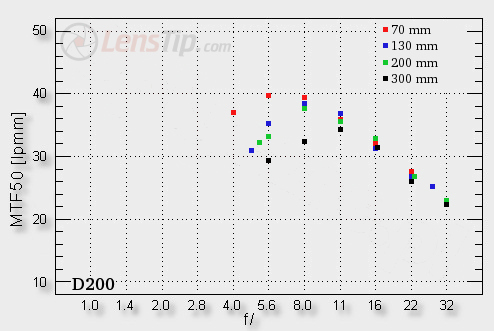
The 70 mm focal length would be difficult to fault. Already at the maximum aperture we see the level of 36 lpmm and on stopping down by 1-2 EV we reach 40 lpmm. On the other hand these results are hardly sensational. The rival Nikkor had the results about 3 lpmm higher here. The Sigma compares well with the Canon 70-300 mm IS for a change, which at the maximum aperture was simply “soft”.
Please Support UsIf you enjoy our reviews and articles, and you want us to continue our work please, support our website by donating through PayPal. The funds are going to be used for paying our editorial team, renting servers, and equipping our testing studio; only that way we will be able to continue providing you interesting content for free. |
- - - - - - - - - - - - - - - - - - - - - - - - - - - - - - - - - - - - - - - - - - - - - - - -
On passing to 135 mm the difference between the Sigma and the Nikkor becomes bigger. That latter shows the same MTF values as at 70 mm but the Sigma’s results decrease. Fortunately on passing to 200 mm we don’t see any image quality deterioration. The Sigma’s problem is that the Nikkor at 200 mm is in fact as good here as it was at 70 mm.
The smallest differences between the Nikkor and the Sigma can be noticed at 300 mm but still the Nikkor fares better there. At this point the Sigma starts looking worse compared to the Canon for a change. It can be considered better when wide open but on slight stopping down the Canon’s results improve swiftly and it reaches higher MTFs that the Sigma, even though it was tested on a less densely packed Canon’s 20D sensor.
Let’s check how the Sigma behaves at a DX sensor’s edge. Appropriate graphs are presented in the picture below.
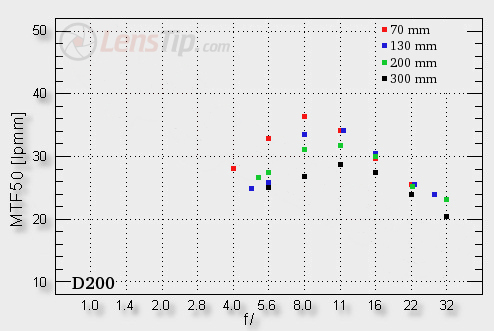
Here the differences between the Sigma and the Nikkor are less pronounced. The latter fares better only at 300 mm wide open. In the 70-200 mm range and on slight stopping down both lenses perform very similarly. When you compare the Sigma with the Canon 70-300 mm IS you must admit it is a bit better for most of aperture/focal length combinations even though the Canon was tested on a less densely packed sensor.
Let’s get down to the description of the full frame results from a Nikon D3x. The graph for the frame centre is presented below.
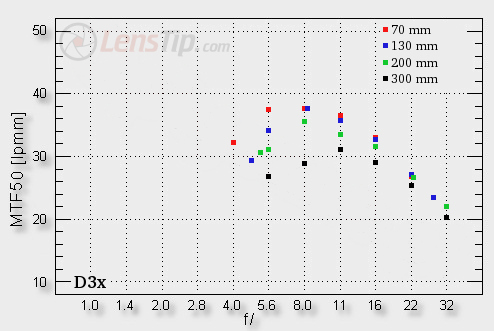
Traditionally, because of a very similar linear pixel density of a D200 and a D3x there is almost no difference between their sensors and a DX sensor (within the margin of error). A slight shift of the zero point for the curves presented is the only thing that can be observed – it is due to lower MTFs values (expressed in lpmm) on the D3x. The lens shouldn’t be blamed here but the sensor exactly.
The full frame’s edge that’s another story. It is located a lot further from the optical axis than in the case of the DX sensor’s edge – small wonder there are more problems with getting high results there. How did the Sigma perform? Let’s have a glance at the picture below.
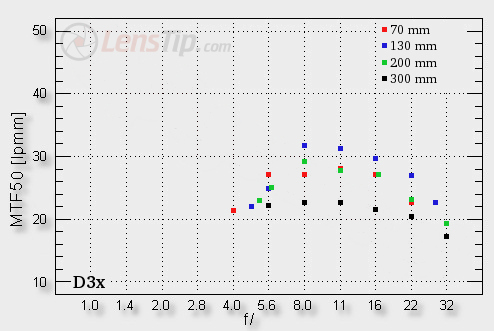
Looking at these results we should perhaps say: it’s a good thing that at longer focal lengths we are mainly interested in areas near the frame centre anyway. When at shorter focal lengths we can get a more or less useful image on stopping down, we won’t manage to achieve that much at 300 mm, where the MTFs are really low and the stopping down almost doesn’t have any effect at all.
At the end of this chapter let’s glance at our test chart crops which were based on JPEG files from the Nikon D200.
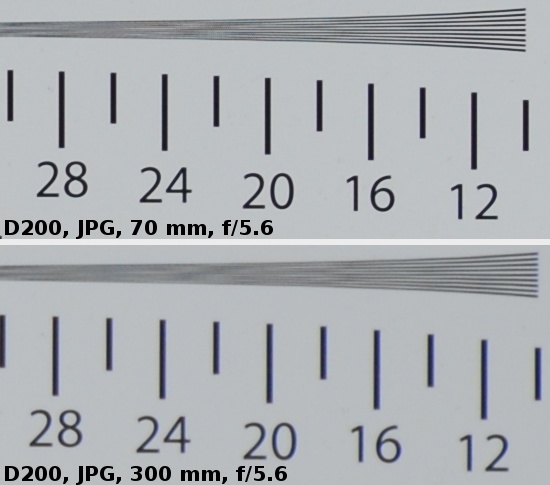 |






